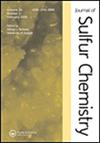5-(苯基氨基甲酰)戊硒基系链酯、酸和反式β-内酰胺的设计、合成、表征、抗菌评价和分子对接研究
IF 1.6
3区 化学
Q3 CHEMISTRY, MULTIDISCIPLINARY
引用次数: 0
摘要
在此,我们揭示了双(5-苯基氨基戊基)二硒酸酯2的应用,以获得独特的硒酸酯,即2-(5-(苯基氨基戊基)戊硒基)乙醇酸3,并进一步将3转化为2-(5-(苯基氨基戊基)戊硒基)乙醇酸4。接下来,从硒酸4和取代亚胺5a-d开始,报道了具有时间效率(15分钟完成)和立体选择性的反式3-((5-苯基氨基)戊基硒基)β-内酰胺6a-d(产率52-78%)的合成,并获得了相关的表征数据(FT-IR, FT-NMR (1H, 13C), CHN元素分析)。体外抗菌和抗真菌生物学评价以及硅分子对接研究显示,在很大程度上依赖于锚定在5-(苯氨基甲酰)戊基硒基链上的功能(功能化硒基- /酯/酸/ β-内酰胺)的性质。体外抗菌研究证明,硒酸酯3和反式硒酸-β-内酰胺6c(在β-内酰胺环的N1和C4原子上结合对甲氧基苯基取代基)对所有测试的革兰氏阳性细菌(金黄色葡萄球菌、枯草芽孢杆菌)、革兰氏阴性细菌(大肠杆菌、铜绿假单胞菌)和真菌(白色念珠菌)都有活性,抑制区直径分别为9-20毫米和8-12毫米。反式-β-内酰胺6b(含c4 -苯基和n1 -对甲基苯基)对金黄色葡萄球菌的抑制带直径最大(14 mm)。观察到配体结合亲和力的分子对接结果与体外抗菌结果非常一致,使这些硒化合物具有潜在的药用价值。本文章由计算机程序翻译,如有差异,请以英文原文为准。
Design, synthesis, characterization, antimicrobial evaluations and molecular docking studies of 5-(phenylcarbamoyl)pentylselenyl tethered ester, acid and trans-β-lactams
Herein, we unveil the utility of bis(5-phenylcarbamoylpentyl)diselenide 2 for obtaining unique seleno-ester viz ethyl 2-(5-(phenylcarbamoyl)pentylselenyl)ethanoate 3 and further transformation of 3 to 2-(5-(phenylcarbamoyl)pentylselenyl)ethanoic acid 4. Next, time-efficient (complete in 15 min.) and stereoselective synthesis of trans-3-((5-phenylcarbamoyl)pentylselenyl)-β-lactams 6a-d (52-78% yields) starting from seleno-acid 4 and substituted imines 5a-d has been reported with relevant characterization data (FT-IR, FT-NMR (1H, 13C), CHN elemental analysis). In vitro antibacterial and antifungal biological evaluation and in silico molecular docking studies exhibit a profound dependence on the nature of the functionality (functionalized selenyl- /ester / acid / β-lactam) anchored to 5-(phenylcarbamoyl)pentylselenyl chain. In vitro antimicrobial studies evidenced seleno-ester 3 and trans-seleno-β-lactam 6c (incorporating p-methoxyphenyl substituents both at N1 and C4 atoms of the β-lactam ring) to be active against all tested gram positive bacterial (S. aureus, B. subtilis), gram negative bacterial (E. coli, P. aeruginosa) and fungal (C. albicans) species exhibiting 9-20 mm and 8-12 mm diameter of inhibition zones. trans-β-Lactam 6b (with C4-phenyl and N1-p-methylphenyl groups) exhibited maximum inhibition zone diameter (14 mm against S. aureus) amongst trans-6a-d. Molecular docking results of ligand binding affinity are observed to be in well agreement with the in vitro antimicrobial results making these seleno-compounds potential candidates of medicinal importance.
求助全文
通过发布文献求助,成功后即可免费获取论文全文。
去求助
来源期刊

Journal of Sulfur Chemistry
CHEMISTRY, MULTIDISCIPLINARY-
CiteScore
4.10
自引率
9.10%
发文量
38
审稿时长
6-12 weeks
期刊介绍:
The Journal of Sulfur Chemistry is an international journal for the dissemination of scientific results in the rapidly expanding realm of sulfur chemistry. The journal publishes high quality reviews, full papers and communications in the following areas: organic and inorganic chemistry, industrial chemistry, materials and polymer chemistry, biological chemistry and interdisciplinary studies directly related to sulfur science.
Papers outlining theoretical, physical, mechanistic or synthetic studies pertaining to sulfur chemistry are welcome. Hence the target audience is made up of academic and industrial chemists with peripheral or focused interests in sulfur chemistry. Manuscripts that truly define the aims of the journal include, but are not limited to, those that offer: a) innovative use of sulfur reagents; b) new synthetic approaches to sulfur-containing biomolecules, materials or organic and organometallic compounds; c) theoretical and physical studies that facilitate the understanding of sulfur structure, bonding or reactivity; d) catalytic, selective, synthetically useful or noteworthy transformations of sulfur containing molecules; e) industrial applications of sulfur chemistry; f) unique sulfur atom or molecule involvement in interfacial phenomena; g) descriptions of solid phase or combinatorial methods involving sulfur containing substrates. Submissions pertaining to related atoms such as selenium and tellurium are also welcome. Articles offering routine heterocycle formation through established reactions of sulfur containing substrates are outside the scope of the journal.
 求助内容:
求助内容: 应助结果提醒方式:
应助结果提醒方式:


